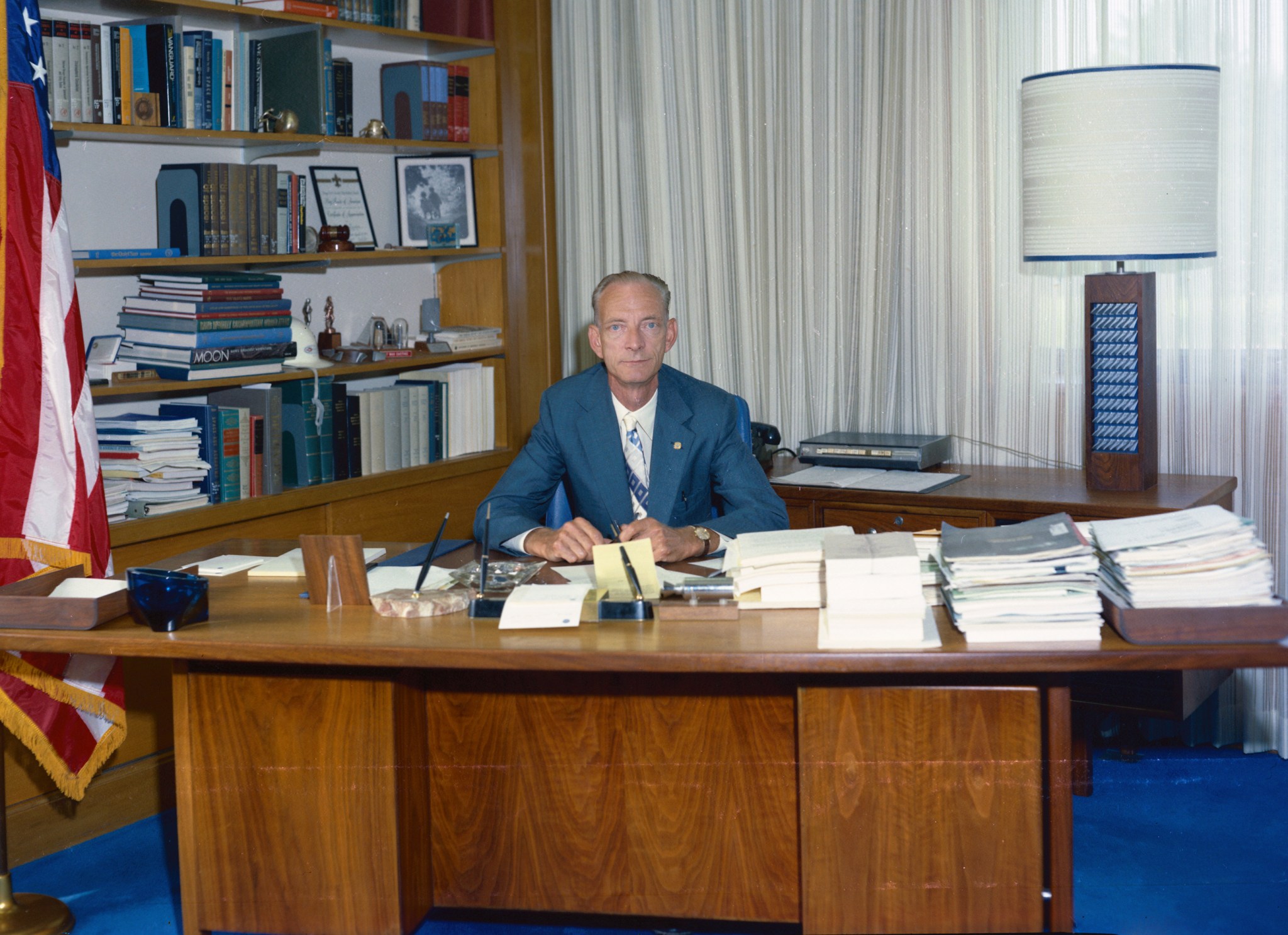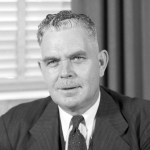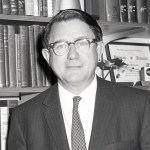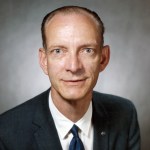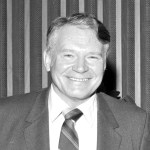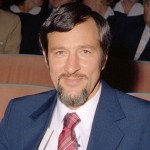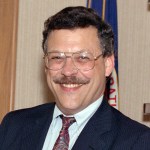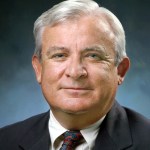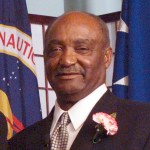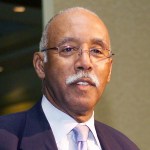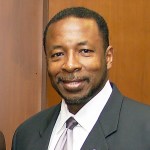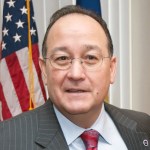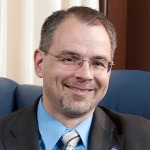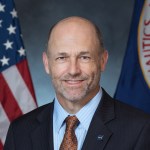
Bruce T. Lundin
Former Director, Glenn Research Center (Nov. 1969–Aug. 1977)
Bruce Lundin served as center director at NASA’s Lewis Research Center from November 1, 1969 to August 26, 1977. During that period, the center underwent significant reductions that returned its budget and personnel to levels that existed prior to the early 1960s ramp-up for the Apollo program. Lundin was able to offset some of the reductions by partnering with other federal agencies on Earth-based research programs. Lundin had over 25 years of research and management accomplishments at the center prior to his term as director.
Lundin was born and raised in Alameda, California. He earned his bachelor’s degree in mechanical engineering in 1942 at the University of California and worked briefly as an engineer for Standard Oil of California. At the urging of a former professor, Lundin accepted a position at the National Advisory Committee for Aeronautics (NACA)’s Aircraft Engine Research Laboratory (today, NASA’s Glenn Research Center) in Cleveland, Ohio. During World War II, Lundin worked as a research engineer studying aircraft engine cooling and the performance of the nation’s earliest jet engines.
During a major reorganization in October 1945, Lundin was named head of the Engine Research Division’s new Jet Propulsion Research Section. There he managed the testing of the first operational afterburner and encouraged the construction of a series of altitude chambers for testing entire jet engine systems in simulated flight conditions. Lundin was named chief of the Thermodynamics Branch in 1949, then assistant chief and chief of the Engine Research Division in 1949 and 1952, respectively.
As division chief, Lundin was continually seeking to identify future trends in aviation and propulsion. He was among the NACA’s most adamant believers that space propulsion was a natural extension of aeropropulsion. Following the launch of Sputnik in 1957, Lundin authored a key white paper that advocated for the creation of a new space organization based on NACA laboratories. The paper would serve as an outline for the establishment of NASA the following year.
In 1958, Lundin was promoted to associate director, managing the center’s research activities. In 1961, he was tasked with directing all of the center’s development work, including the management of the Centaur rocket program. Lundin transferred to NASA Headquarters in early 1968 to serve as deputy associate administrator and then acting associate administrator for the Office of Advanced Research and Technology.
Lundin’s stint in Washington was short; however, as he was tapped to fill the Lewis center director vacancy caused by Abe Silverstein’s retirement in the fall of 1969. Lundin found himself at the helm during the most difficult period in the center’s history. NASA, which had just landed on the Moon, began rolling back the Apollo-era budget levels. Hundreds of employees were separated from the center over the next two years.
NASA’s cancellation of its nuclear propulsion and power programs in early 1973 led to the loss of hundreds more employees and the mothballing of the center’s remote test site at Plum Brook Station (today, NASA’s Neil Armstrong Test Facility). The center’s morale and sense of unity eroded during this period. Lundin’s reluctance to follow the agency’s attempt to hire contractors to perform some non-technical roles resulted in tensions and increasing isolation from NASA Headquarters. In addition, the center did not have a significant role in the early development of the space shuttle.
It was in this environment that Lundin began increasing aeropropulsion research and reaching out to other federal agencies to resolve problems on Earth. The former effort sought to address new civilian aviation problems such as fuel efficiency, noise abatement, and emissions reduction. Lewis partnered with industry on a string of propulsion tests in the 1970s and began testing full-scale engines for the first time in years. The center also initiated studies of high-speed turboprop engines.
With the nation’s increased awareness of environmental issues in the early 1970s, Lundin was able to levy the center’s aerospace experience to terrestrial issues, including clean energy, alternative propulsion, and pollution monitoring. Lundin partnered with the Department of Energy, the National Oceanic and Atmospheric Administration, the Environmental Protection Agency, and Federal Aviation Administration during this period. This resulted in an array of new endeavors, such as the development of large wind turbines, mapping ice cover on the Great Lakes, exploring methods for clean burning of coal, creating batteries for electric vehicles, and establishing solar villages.
Despite constant budget and programmatic struggles, Lundin’s time as center director included major success stories, as well, including breakthroughs in space communications and energy conversion. The center also managed the launching of over 30 prestigious missions on Atlas-Centaur and Titan-Centaur vehicles, including Pioneer 10, Mariners 6 and 7, Mariner 10, and the two Viking missions.
Lundin also instituted an extensive employee recognition program that recognized the work and accomplishments of teams across all areas of the center. Lundin frequently spoke at the ceremonies, and features appeared in nearly every edition of the center newsletter. Lundin also initiated a lecture series in which subject matter experts from both external organizations and the center spoke to employees on various topics.
Lundin chaired the NASA Investigation Board for the Skylab mission in 1973 and the Helicopter Management Review Group in 1976.
Lundin retired in 1977 after 35 years of federal service. He subsequently served on a number of review boards, including the President’s Commission on the Accident at Three Mile Island. Lundin passed away in 2006 at the age of 86.
Lundin’s awards include the Cleveland Technical Society Council’s Technical Award (1953), NASA’s Medal for Outstanding Leadership (1965), NASA’s Public Service Award (1971), and NASA’s Distinguished Service Medal (1971). In 1966, he was selected to deliver the Jennings Scholar Lecture, in 1975 he was awarded an honorary Doctor of Engineering degree by the University of Toledo, and in 1976 he was elected to the National Academy of Engineering and received the National Space Club’s Astronautics Engineer Award. He was inducted into the NASA Glenn Hall of Fame in 2015.
Additional Resources


























